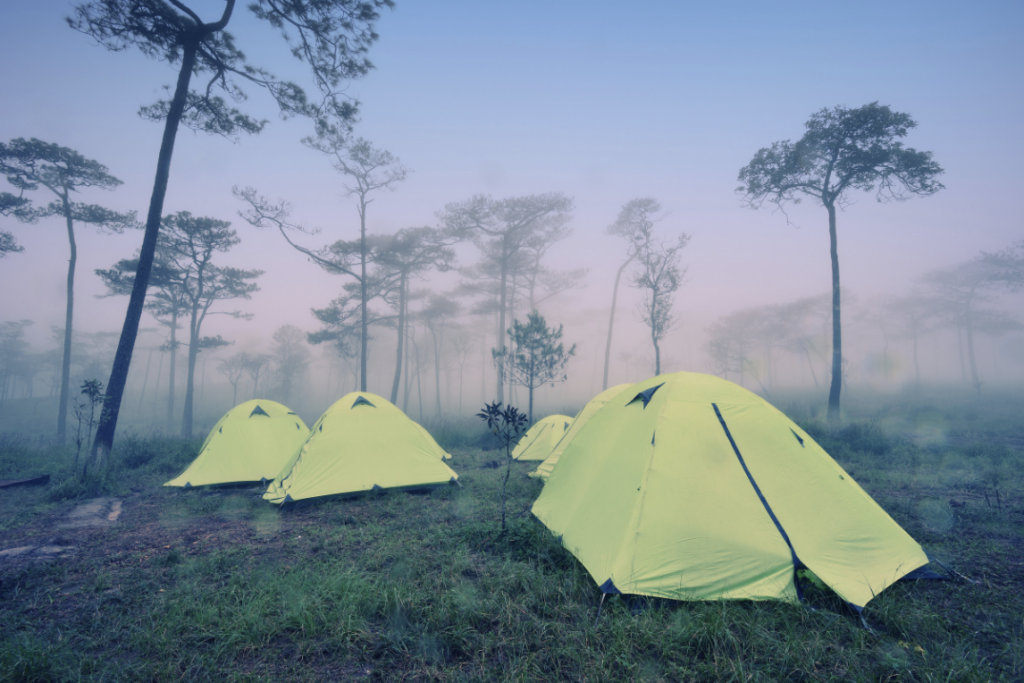
Nothing can ruin a camping trip like a leaky tent. You might be wondering, are tents waterproof? I’ve asked this question myself when I first started.
After 6+ years camping in all kinds of weather and 8+ hours spent doing in-depth research, I can answer with certainty that:
Tents are not waterproof but rather highly water-resistant. They significantly slow down the penetration of rainwater but do not prevent it. You can tell how waterproof a tent is based on its waterproof rating, seams, and floor protection. Be prepared to waterproof your tent every 1 – 2 years as even the best ones leak eventually.
I want to highlight that many tents are not waterproof at all, even if the manufacturer says it is. So use your judgment. We will go over what to look for in a waterproof tent in detail.
This is a long article, so feel free to jump to any section you want:
How to Know If a Tent Is Waterproof
A lot goes into building a waterproof tent. Many have a rain fly that covers the top or parts of the body. The fabrics, coating, floor, and seams all need to be waterproofed separately.
And it’s not as black and white as you think. Instead, there’s a scale or spectrum of how waterproof a tent is, which leads me to the waterproof rating.
What the Waterproof Rating Actually Means
Browse some product listings for tents. You will quickly find many include a waterproof rating, referred to as the Hydrostatic Head (HH).
It’s essentially a measure of how much water pressure the tent walls or floors can handle before the water starts to seep in. It’s usually measured in millimeters (mm). For the more technically inclined, feel free to read more here.
Note that all the fabrics eventually leaked under enough pressure, and nothing was 100% waterproof.
So instead, the waterproof rating is a measure of how water-resistant the fabric is. Water-resistance means that the material slows down the absorption of water but is unable to completely prevent it.
The higher the waterproof rating, the longer a tent will stay leak-free. In this article, I will use “waterproof” and “water-resistant” interchangeably.
Here’s what you can expect from a brand new tent with all parts adequately waterproofed (with many caveats):
- 1000mm – 1500mm fly rating: could handle dry weather or light rain showers; most 2- to 3-season tents fall in this range
- 1500mm – 3000mm fly rating: could handle moderate rain and some downpours
- 3000mm+ fly rating: could handle heavier rain and snow
But the waterproof rating alone is not a reliable predictor of a tent’s performance in the rain because it only measures how water-resistant the fabrics are. This means nothing if your seams are not sealed properly or if there are holes in your rainfly.
You might have read that a waterproof rating above 1000mm means the tent is considered waterproof. But this is highly misleading and overlooks all other elements. The vast majority of tents on the market are rated 1000mm and above, but obviously, not all are leak-free. In fact, I’ve had leaks in 2000mm tents before.
The ratings I mentioned above are for rain flies or walls. But tent floors should have a higher waterproof rating, around double that for the rainfly. This is because tent floors are rubbed against rough grounds and will endure much more abrasions than tent walls. And you may be surprised by how much rainwater can pool under your tent.
The waterproofness of your tent will also degrade over time from wear and tear to the coating and seams. Expect your 5-year-old tent to perform worse than what the manufacturer states.
Waterproof Fabrics and Coatings
Most modern tents are made of nylon and polyester rather than canvas, so that’s what we will focus on in this section.
Neither nylon nor polyester is waterproof by itself. So the coating is the key to waterproof tent walls and rain flies.
The coating could be polyurethane (PU), silicone, or a durable water repellent. More waterproof tents have a combination of these or multiple layers of coatings.
The most common one is PU (polyurethane), but it’s generally not the most durable option. It can be damaged by exposure to UV rays, so make sure to set up your tent in shaded areas or put them down during the day to protect this coating.
Moreover, PU actually slowly absorbs water, so it’ll leak eventually if there’s enough moisture. And if you plan to use your tent for many years, PU will react with the moisture and result in a smelly, leaky tent.
Silicone coatings will be waterproof for a longer time than PU coatings. It can’t be damaged by UV, doesn’t absorb water at all, and won’t react with moisture in the air. Many manufacturers coat their tents with silicone on one side and PU on the other, so look for Sil/PU or Sil/PE coatings in the description. Sil/Sil coatings are pretty rare.
A note is that canvas tents are waterproof after certain preparation without any coating. Canvas is breathable and naturally absorbs water. If you wet it before your camping trip, the fibers will expand and eliminate all the pores, waterproofing the tent.
To learn more about the pros and cons of different fabrics, check out this article.
Tent Seams
I know we talked about how coatings impact long-term waterproofness, but the seams determine if your tent will last even one night in the rain.
The seams are the most vulnerable parts because there are holes and gaps. So they must be sealed for the tent to be waterproof.
Here are what you should look for in a waterproof tent:
Taped seams
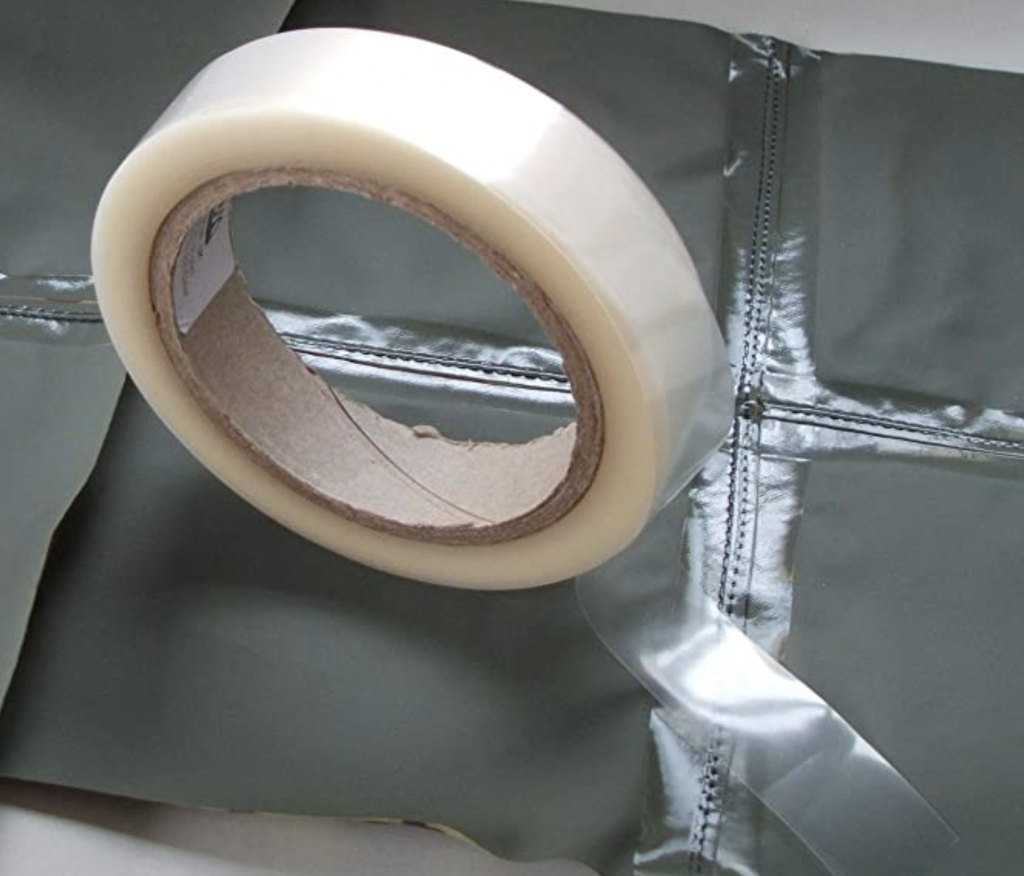
No, this is not using the tape in your house and putting it on your seams. That would come off too quickly.
Instead, manufacturers use heat and pressure to melt the tape into the tent fabrics. Taping seams are the most common way to waterproof a tent.
Taping the outside seams is absolutely necessary, but some manufacturers also tape the inside seams for added protection.
Also, keep in mind that some tents don’t have all seams sealed. Sometimes only the critical parts are sealed to save costs.
And just like the waterproof coating, taped seams could come apart over time and become no longer waterproof.
Inverted seams
This refers to when two pieces of fabrics are sewn together inside the tent so that there are no gaps for the rainwater to get through.
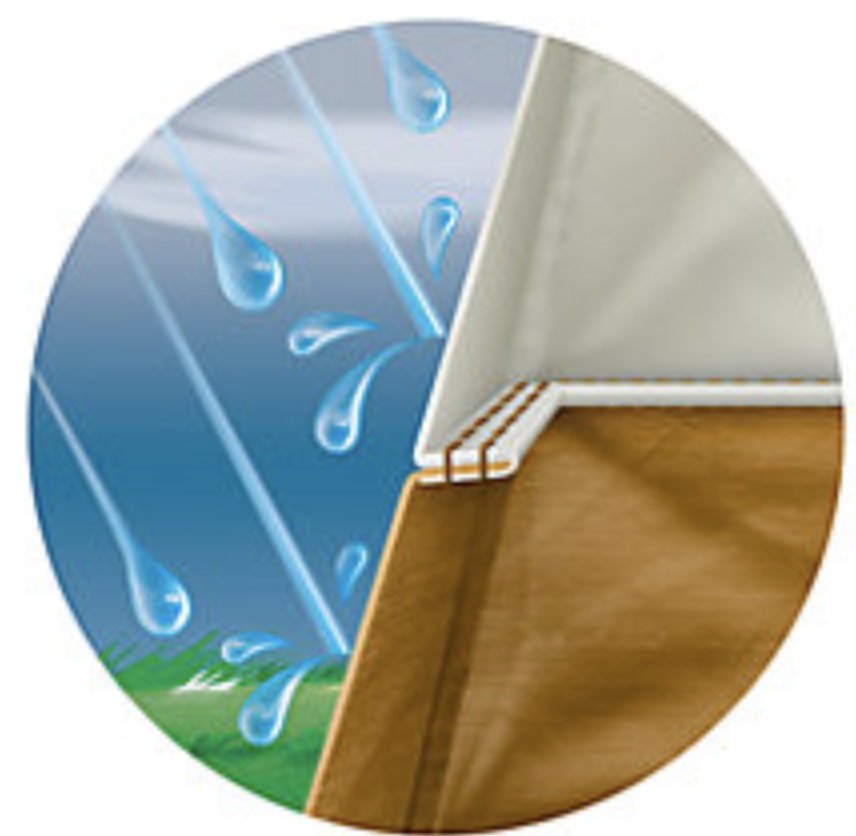
Inverted seams tend to be more durable than taped seams since they don’t easily come apart.
Welded seams
This refers to when 2 pieces of fabric are welded together through heat and pressure. There will be no stitching or holes from this procedure. From what I see on the market, welded seams are most commonly used to seal tent floors.
Tent Floor
Everyone thinks about the tent walls and rain flies when it comes to keeping themselves dry. But your tent floor is equally important since the ground will be muddy during rain, and water may pool under your tent.
The tent floor needs to have thicker coatings to stay waterproof since it’ll rub against some rough surfaces. Look for a rating of at least 2000mm.
Construction-wise, look for the bathtub floor. This means the thick floor fabrics extend further up the walls of the tent, as shown in the image below:
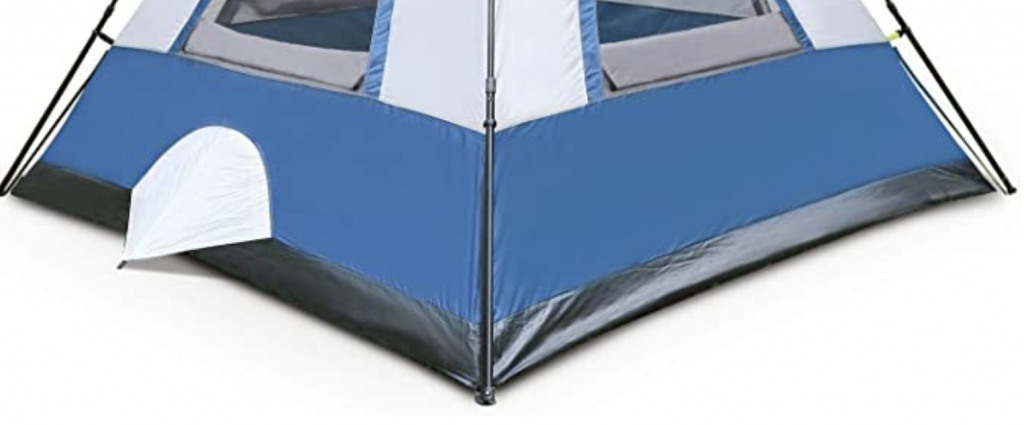
This will provide extra protection when water builds up on the ground surrounding your tent.
And, of course, check if the seams are sealed.
Are More Expensive Tents More Waterproof?
You might think spending more on a tent will provide better insurance against being soaked in it. But this is not necessarily the case.
You don’t need to spend more than $100 to get a good waterproof tent, nor should you expect a more expensive tent to automatically be fully waterproof.
The waterproof rating, coating, seams, and fabrics still indicate waterproofness in the same way regardless of the price. Some expensive tents don’t come with sealed seams or have less coating because it has to be lightweight.
That being said, cheap tents are more of a hit or miss when it comes to waterproofing. I know Coleman tents are very water-resistant (read more here), but check out this video for an example of a leaky tent.
It was only $35, and the manufacturer claimed it was waterproof. But oh, my, god, was there a ton of water pooling on the floor after only 40 minutes of light rain showers!
Do All Tents Leak in Heavy Rain?
Not all tents leak in heavy rain. Use a tent with a waterproof rating above 3000mm and a full-coverage rainfly if you expect to camp in heavy rain. You should also examine your tent for any leakage points before the trip.
As we discussed before, the higher the waterproof rating, the better chances you have of staying dry. Usually, 3000mm or more for the rain fly and 5000mm+ for the tent floor is sufficient even in downpours. The manufacturer will likely clearly state this in their description as this is a huge selling point.
And if you are in a rainstorm, chances are that it’ll be very windy. If your rainfly only covers the ceiling, the wind can easily blow the rainwater into your tent through the meshed fabrics on top or on the doors. So it’s best to get a tent with a rainfly that covers it from top to bottom. You can use a zipper to control how much you want to open the rainfly.
Lastly, check how the seam tapes are holding up and any holes or slits in the fabrics—waterproof your tent as needed before you head out.
Are Coleman Tents Waterproof?
Coleman tents are highly waterproof thanks to their inverted and welded seams, along with the anti-wicking threads and zipper protection. In fact, Coleman probably has the best waterproofing among all budget tent brands. That being said, most Coleman tents will not be leak-free in heavy rain unless you apply waterproof treatments.
I spent 1+ hours reading all the Amazon reviews and looking at Coleman’s website to arrive at this answer. My personal experience alone won’t be enough since the quality of the tents will vary.
Take this Coleman Sundome tent, for example. It has 29,000+ reviews in total and 300+ reviews related to waterproofness.
People’s experiences varied, but the general takeaway is that leaking isn’t a problem in regular rain showers but could happen during downpours, especially if you’ve been using the tent for a while. Because of this, many recommended that you still apply a seam sealant before going camping in the rain.
Coleman’s website also describes their waterproof system in detail. The wall seams are inverted, and the floor seams are welded together so that no holes or gaps are exposed. And they use an anti-wicking thread in their fabrics, which means it pushes water away rather than absorbs it.
What I found odd is that there’s no mention of waterproof coatings. I’m sure it’s applied because anti-wicking materials aren’t sufficient by themselves.
But given this is a budget tent, don’t expect the coatings to last a long time. Waterproof your tent once in a while.
Are Single-wall Tents Waterproof?
Single-wall tents can be fully waterproof, similar to double-wall tents. However, you are still more likely to get wet in a single-wall tent due to the condensation and sagging of fabrics.
Let’s first get the definitions straight. The majority of tents in the market are double-wall tents, meaning they have a separate rainfly. The rainfly can cover just the ceiling, halfway down the tent, or from top-to-bottom.
The sole purpose of this outer layer is to prevent the inside from getting wet, while the inner wall adds ventilation. In the case of the Coleman Sundome, the walls underneath the rainfly are mesh:

In a single-wall tent, however, one layer of fabric has to perform both functions. This means to make it waterproof, it has to sacrifice breathability.
As a result, single-wall tents will lock in more moisture throughout the night and have more condensation. Of course, manufacturers have come up with ways to mitigate this issue. Still, nothing beats meshed walls in terms of allowing airflow.
Single-wall tents are also likely made of nylon with light coating for sake of weight savings. And nylon does absorb a small amount of water, causing the walls to sag.
Why is this a problem? Well, sagging walls create more “flat” areas where rainwater will pool together rather than run down the tent. And those little puddles of water put more pressure on the fabrics.
As a result, the walls are more likely to be damp in a single-wall tent, even if the water doesn’t get through completely.
Are 4-Season Tents Waterproof?
4-season tents are typically waterproof, similar to 3-season tents. Most are built with thick layers of fabric and full-coverage rain flies to handle harsh and windy conditions. However, you should not get a 4-season tent only to get more waterproofing.
“4-season” is a misnomer since most 4-season tents would be too stuffy if used outside of the winter season. The thick walls and top-to-bottom rain flies make ventilation worse than your typical 3-season tent. You don’t want to be sweating like crazy on a summer night.
You’ll also be paying more for extra sturdy poles built for high winds. But most of you won’t need it.
Also, note that some 4-season tents only have a single wall to keep the weight low. This is less ideal for waterproofing, as we discussed in the section above.
Therefore, you shouldn’t use a tent’s season rating to judge its performance in rain. Stick to the basics like waterproof rating, and seam and floor protection.
How Long Do Tents Stay Waterproof?
A typical tent will stay fully waterproof for 1 – 2 years, after which you should re-apply waterproof treatment. However, the timing varies widely based on the quality of the tent and how you take care of it.
Let’s start with the tent’s construction. As we discussed earlier, the coating on the fabrics is key to keeping it waterproof, but it does wear down over time. So the thicker the coating, the longer it will stay waterproof. The waterproof rating is a good indicator of this.
The taped seams will also start to come apart after 15 – 30 nights of camping in it, and holes may appear on the tent floor.
Yes, a more expensive and high-quality tent will last longer. But you should still check for any weak areas before every camping trip and waterproof your tent at least every 3 years.
Also, note that some tents don’t come with sealed seams or protected floors. In that case, be ready to waterproof it before your first trip.
To make your tent waterproof for longer, protect the coating and seams as much as possible:
- Try to keep it out of the sun as much as possible
- Avoid cleaning it with a washing machine or strong detergent
- Always store your tent dry
- Use a ground tarp to minimize abrasions to the floor
And if you want to learn more about how long your tent should last, check out this article, where I went into much more detail.
How to Waterproof Your Tent
We’ve referenced several times in this article that you should waterproof your tent. We’ll focus on nylon/polyester tents in this section as they are the most common.
This process is quite simple and a lot cheaper than buying a new tent.
The first step is to thoroughly check for any problem areas. Follow these steps:
- Stake out your tent in a spot with good lighting and ventilation
- First, check if there are any holes in the rainfly. Even 1mm tiny holes can make your tent quite wet if it rains long and heavy enough.
- Then remove the rainfly to examine the tent walls and seams. Are the seams protected at all? Is the tape peeling? Do you see any holes?
- Check the doors and zippers. Make sure no mesh is exposed and the zipper is still well-protected.
- Then gently put your tent on its side so that you are facing the floor. Check for any coating that’s peeling and any holes or slits.
- Check the seams inside your tent if they are supposed to be taped or inverted. Look again for any holes in the floor.
If your coating is separating from the walls or floors in large areas, I recommend getting a new tent. While you can still use a seam sealer or durable water repellent to waterproof it, I wouldn’t risk it.
If the problems aren’t so severe, here are some ways to waterproof your tent:
Sealing the Seams
To do this, you will need some rags, a seam sealer, and a small brush that usually comes with the sealer.
Note that you need to pick the right sealer for your tent’s material. Silicone coating will require different sealers than PU coating.
For the latter, I highly recommend this GearAid seam sealer. I’ve been using it for years, and it’s worked wonderfully every time. They also have a variation for silicone coatings.
Steps:
- Clean the seams with a wet rag
- Apply the seam sealer and distribute it evenly with a brush
- Wait for it to dry
And boom! You’ve waterproofed a tent just like that!
MSR Gear has an excellent video demonstration:
Patching any Holes
It goes without saying that your tent will leak if there are any holes. I personally use this Gear Aid Gore-Tex patch. It’s highly waterproof but also breathable.
The steps couldn’t be more straightforward:
- Quickly clean the areas around the hole
- Cut an appropriate amount of repair tape; try to round the edges so that it doesn’t peel off easily
- Tape it onto your tent, and you’re done!
Spray with Durable Water Repellent (DWR)
DWR works particularly well for waterproofing large areas of your tent. It’s like adding more coating. But I still recommend you seal the seams separately since they are particularly vulnerable.
Steps:
- Clean your tent
- Spray the DWR; you don’t have to wait for the walls to be dry
- Wipe off any excess coating after a few minutes
- Let it dry completely
Now your tent should be waterproof, and you are ready to go!
Can You Put a Tent Up In the Rain?
Yes, you can put up a tent in the rain without getting wet. Set up a tarp first to create a dry area and avoid spots where water may pool up or flood into your campsite.
You’ve spent a lot of time making sure your tent is waterproof, but what if it’s already raining when you get to your campsite? How do you keep the inside of your tent dry throughout the set-up process?
Before we create any temporary shelter, the key is to pick a spot that’s slightly higher than its surrounding areas so that water won’t be flowing to your campsite. Low-lying areas are a big no-no.
Also, avoid setting up camp too close to rivers or streams as they may flood in heavy rain.
After picking an appropriate site, set up a tarp so that you can stay dry underneath:
- Tie a line between 2 trees (the ridgeline)
- Hang the tarp
- Guy out the flies
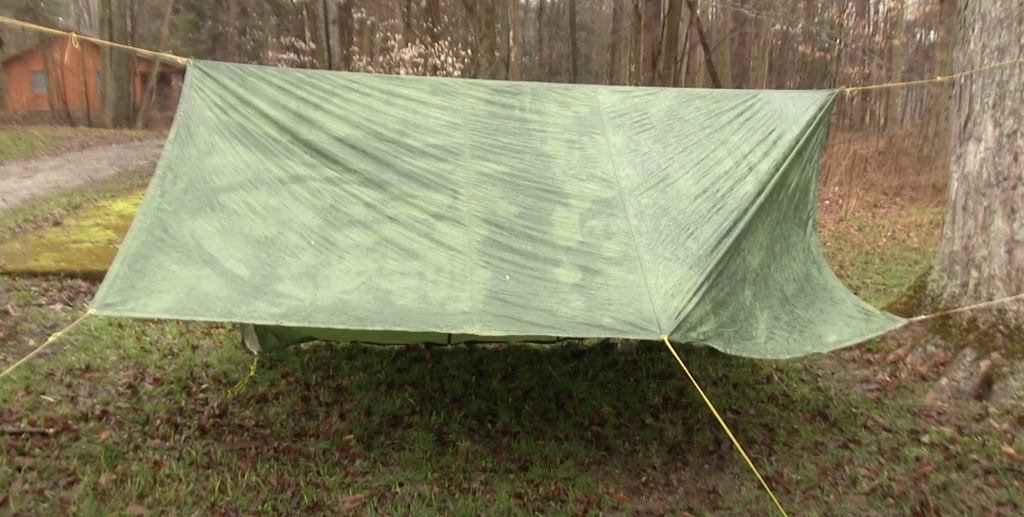
Then simply set up your tent under the tarp! Check out this video for detailed steps.
It’s an added bonus to bring a sponge, which can soak up any water in case it gets into your tent.
If you have to set up a tent in the rain pretty often, consider getting tents with zipped panels rather than meshed walls to not expose the most vulnerable parts.
Summary
There you have it! The ultimate guide to whether tents are waterproof. I know it’s a lot of information, so I hope I didn’t overwhelm you.
Whenever you’re unsure, just go back to the basics: check the seams, floors, coating, and waterproof rating. And waterproof your tent every 1 – 2 years. Then you’ll stay dry on all your camping trips and never have to worry about leaking again.














